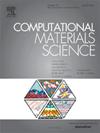基于crbr3的范德华磁隧道结的巨隧穿磁阻
IF 3.3
3区 材料科学
Q2 MATERIALS SCIENCE, MULTIDISCIPLINARY
引用次数: 0
摘要
最近二维(2D)层状本构铁磁体的发现为克服传统磁性隧道结(MTJs)的技术挑战和开发基于二维材料的范德华(vdW) MTJs提供了一个理想的平台。本研究基于非平衡格林函数第一性原理计算,研究了一类基于铁磁CrBr3单层的vdW MTJs,即1T-TMX2 /CrBr3/NM间隔层/CrBr3/ 1t - tmx2 vdW MTJs (TM = Mo, W;X = S, Se)。最重要的是,我们确定了分别以1 T-MoSe2和2H-MoS2作为电极和纳米间隔的vdW MTJ(标记为MTJ4)是实现优异的自旋滤波(PMTJ = 99.98%)和巨大的TMR比(4.07 × 105%)的最有利模型。对实际空间投影LDOS、层依赖DOS和差分电荷密度的分析进一步表明,MTJ4的巨大TMR效应来自于1 T-MoSe2/CrBr3界面电荷转移引起的半金属CrBr3自旋依赖传输势垒。此外,还验证了MTJ4在小偏置电压下的高性能自旋输运的鲁棒性。我们的工作表明,二维CrBr3铁磁体在低维自旋电子器件中具有很好的应用前景。我们的研究也为实验设计和制造高性能二维vdW mtj铺平了道路。本文章由计算机程序翻译,如有差异,请以英文原文为准。

Giant tunneling magnetoresistance in CrBr3-based van der Waals magnetic tunnel junctions
The recent discovery of two-dimensional (2D) layered intrinsic ferromagnets provides a desirable platform for overcoming technical challenges posed in traditional magnetic tunnel junctions (MTJs) and developing van der Waals (vdW) MTJs based on 2D materials. In this research, based on first-principles calculations associated with non-equilibrium Green’s function, we investigated a class of vdW MTJs based on ferromagnetic CrBr3 monolayer, namely 1 T-TMX2/CrBr3/NM spacer/CrBr3/1T-TMX2 vdW MTJs (TM = Mo, W; X = S, Se). Most importantly, we determined that the vdW MTJ (marked as MTJ4) with 1 T-MoSe2 and 2H-MoS2 as electrodes and NM spacer respectively, is the most favorable model for achieving excellent spin-filtering (PMTJ = 99.98 %) and huge TMR ratio (4.07 × 105 %). Analyses of real space projected LDOS, layer-dependent DOS, and differential charge densities further revealed that huge TMR effect of MTJ4 comes from the spin-dependent transmission barrier due to half-metallic CrBr3 induced by charge transfer at 1 T-MoSe2/CrBr3 interface. Moreover, robustness of high-performance spin transport in MTJ4 at small bias voltages was also verified. Our work suggests that 2D CrBr3 ferromagnet possesses promising prospects in low-dimensional spintronic devices. Our research also paves the way for experimentally designing and manufacturing high-performance 2D vdW MTJs.
求助全文
通过发布文献求助,成功后即可免费获取论文全文。
去求助
来源期刊

Computational Materials Science
工程技术-材料科学:综合
CiteScore
6.50
自引率
6.10%
发文量
665
审稿时长
26 days
期刊介绍:
The goal of Computational Materials Science is to report on results that provide new or unique insights into, or significantly expand our understanding of, the properties of materials or phenomena associated with their design, synthesis, processing, characterization, and utilization. To be relevant to the journal, the results should be applied or applicable to specific material systems that are discussed within the submission.
 求助内容:
求助内容: 应助结果提醒方式:
应助结果提醒方式:


